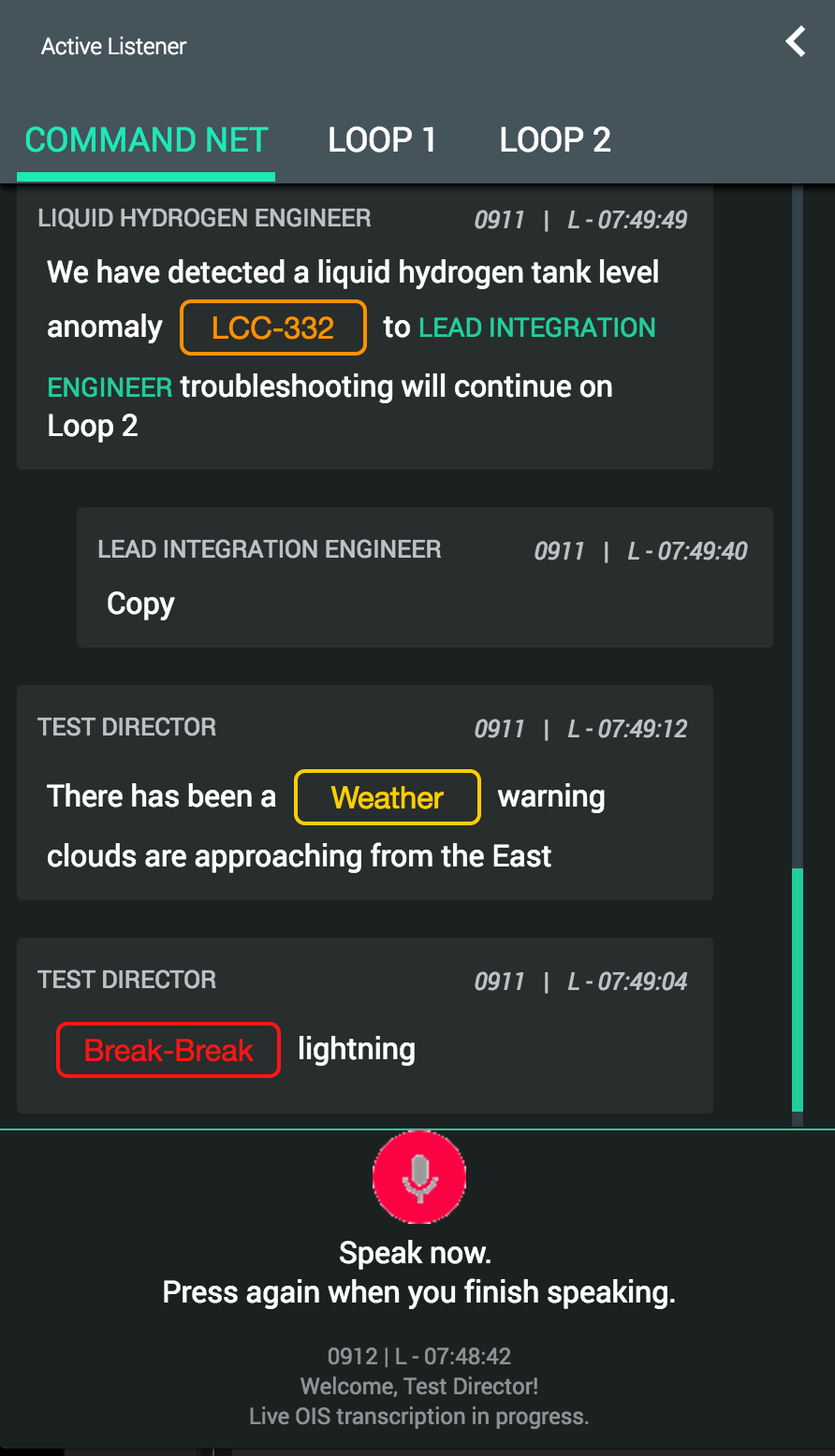Designing and Iterating
After spending about five months researching and coming up with four main insights, we narrowed to three main problems that we were trying to solve.
Three Main Problems to Solve
Lose Critical Event Prioritization over OIS
With verbal communication over the Operational Intercom System (OIS), all information is disseminated with equal importance. The Integration Engineer is often listening to six to eight active channels simultaneously. Critical event announcements that require immediate attention, like the incorrect amount of liquid hydrogen in the fuel tank, must compete with less pressing dialog.
Miss Valuable Information on the Intercom System
Information communicated over OIS is only temporarily available. If the Integration Engineer misses part of a conversation, he must ask the speaker to repeat. This is an unnecessary encumbrance in the fast-paced and high-stress troubleshooting environment.
Unable to Quickly Access Relevant Information
NASA generates a huge amount of data leading up to launch, but only a small subset of this data is helpful to the Integration Engineer. Time is very valuable, especially toward the end of launch countdown, so it is disadvantageous when the Integration Engineer must spend time searching for the data he needs.
Three Main Solutions
Notifications
Notifications grab the Integration Engineer’s attention to provide the right information at the right time. Critical events must emerge from the cacophony of less significant verbal exchanges. Notifications ensure that the information the Integration Engineer receives is prioritized and clear.
Transcription
Transcription provides a permanent backup of the information shared among experts during launch countdown. Engineers can refer to the information whenever necessary. Furthermore, the transcript serves as an entry point into the data.
Data Integration
In order to be useful, the data the Integration Engineer views must be relevant. The dashboard’s hierarchy and structure empower the Integration Engineer to rapidly access the important information he needs to support his decisions.
Notifications
Notifications serve the Integration Engineer the information he needs, right when he needs it. Although Loop rarely aims to pull the Integration Engineer’s attention away from his complex and vital work, there are five categories of critical events that the Integration Engineer can not afford to miss. “Break-break” alerts are of the highest importance and alert the launch room team to stop whatever they are engaged in, as there is a critical issue that must be resolved. Anomaly calls are the second-most important type of notification. They denote the start of the troubleshooting process led by the Integration Engineer. The Integration Engineer also needs to act when his call-sign (his title in the launch room) is mentioned. Lastly, events such as Milestones, such as the start of fueling, and weather conditions, such as lightning or winds over a certain threshold, also demand the Integration Engineer’s immediate attention. Currently these events are only announced over the intercom, where they must compete with many conversations happening simultaneously. Conversely, Loop uses notifications to provide a redundant and prominent avenue to receive this essential information.

Transcription

The Integration Engineer always misses important information said over OIS. Powered by Google Cloud Speech API, Loop transcribes every communication channel and allows the user to navigate between them. The transcription of simultaneous lines of verbal communication provides the Integration Engineer with a point of reference that he can access whenever necessary. It also highlights significant words and transforms them into buttons to direct users to relevant information. Details in the scroll bar empower the Integration Engineer with the ability to scan the transcription for specific details that are relevant to his current task.
NASA personnel in the launch room customize their tools and workspace using post-it’s, annotations, order, and other techniques. Our research revealed that they find this sort of personal organization reassuring and helpful. Therefore, it is important that Loop also enables customization, and this is available with keywords. The Integration Engineer can enter specific keywords that are important to him and the transcription will highlight them, making them easily identifiable.
Data Integration
NASA generates an exorbitant amount of data on every aspect of the vehicle. The Integration Engineer needs to access this information when troubleshooting an anomaly. Loop’s data integration in the Dashboard empowers the Integration Engineer to interact with disparate data presented succinctly and intuitively, uncovering relationships between related technical requirements and real-time telemetry sensor data from the spacecraft and rocket. Within this unified, customizable environment, the Integration Engineer can move onto in-depth analysis, status discovery, and towards finalizing a decision to launch. Loop also presents a variety of methods to access this information because each scenario can require a vastly different approach.
